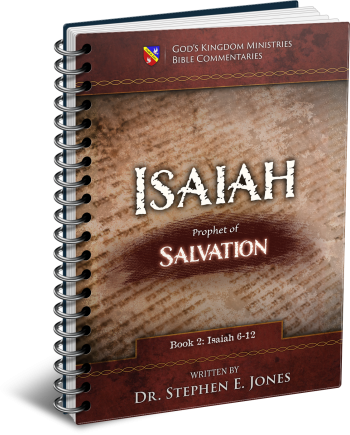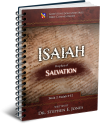Latest Posts
View the latest posts in an easy-to-read list format, with filtering options.

Isaiah is the prophet of Salvation. He is also known as the truly "Universalist" prophet, by which is meant that He makes it clear that salvation is extended equally to all nations and not just to Israel. He lived to see the fall of Israel and the deportation of the Israelites to Assyria, and he prophesied of their "return" to God (through repentance). He is truly a "major prophet" whose prophecies greatly influenced the Apostle Paul in the New Testament.
Category - Bible Commentaries

Isaiah 11:6-9 says,
6 And the wolf will dwell with the lamb, and the leopard will lie down with the young goat, and the calf and the young lion and the fatling together; and a little boy will lead them. 7 Also the cow and the bear will graze, their young will lie down together, and the lion will eat straw like the ox. 8 The nursing child will play by the hole of the cobra, and the weaned child will put his hand on the viper’s den. 9 They will not hurt or destroy in all My holy mountain, for the earth will be full of the knowledge of the Lord, as the waters cover the sea.
If this is to be taken literally, we would expect to see physical changes in the dental structure of wolves, leopards, lions, and bears. Currently they are carnivores and have fangs to tear apart meat. If they are to become vegetarian in the Kingdom, they would need teeth to grind grain and grass. Vipers and cobras would no longer have venom to paralyze their prey. The prophet does not say anything about their change of diet but speaks only of their good-natured friendship, especially with children who know nothing of danger.
The prophet’s main point is found in verse 9, “They will not hurt or destroy in all My holy mountain.” It is a picture of nature that has changed and creation that has been reconciled. At the present time, the word says, “we do not yet see all things subjected to Him” (Heb. 2:8). But when all things are put under the feet of Christ, beasts of prey will no longer pose a danger.
It appears that animals will be in the Kingdom, for they were created for a purpose and were pronounced “very good” in Gen. 1:31. God is interested in all of His creation, not just with mankind. In that day we will live on a renewed and restored earth, where the beauty of nature is seen as it was originally intended—to give us pleasure and to give us work to do. Mankind will be responsible to tend the earth, for this is inherent in man’s authority to “subdue” the earth (Gen. 1:28).
For this reason, we must take Isaiah’s words at least somewhat literally, for the Kingdom of God would be a sterile place if there were only people and streets of gold. Men tend to muddy the waters by confusing the Kingdom with heaven and salvation with reconciliation. Because they cannot conceive of animals “going to heaven,” they think that animals will play no role in the restored Kingdom.
Many, however, have wondered if their favorite dog companion will “be in heaven” with them. In my opinion, animals, birds, flies, and mosquitos will not be resurrected; however, what law would prevent someone from raising one’s favorite dog from the dead in order to find greater pleasure in the Kingdom of God? Resurrection is part of the re-creation of the new heavens and the new earth. As Amen people, based on Rev. 3:14, will we not be given the power of resurrection?
There are many mysteries and secrets not yet clearly revealed, but in my view, the immortal overcomers in that day will have authority over death itself. The only requirement is that we do all things in accordance with the nature and will of God. This will not be a problem, of course, since His law and nature will be written on our hearts, and we will do His will by nature always.
Isaiah’s description of universal harmony is the outworking of the promise of God: “For the earth will be full of the knowledge of the Lord, as the waters cover the sea” (Isaiah 11:9).
When this promise was first given to Moses in Num. 14:21, the explanation was limited to His promise to overcome Israel’s resistance and reluctance to enter the Promised Land. Isaiah expands this to show that the Promised Land is the Kingdom, reconciled and restored to the purpose for which God intended from the beginning.
Isaiah 11:10 continues,
10 Then in that day the nations will resort to the root of Jesse, who will stand as a signal for the peoples; and His resting place will be glorious.
The “root of Jesse” is the Messiah. He will be the flag, banner, or standard around which the people will rally. Banners were also used as signals, which is how the NASB understands it. We may equate the “signal” to the gospel being preached to the world, ultimately causing all to come to Him.
The prophet’s main point, however, was to picture Christ’s “resting place.” The concept of entering into “rest” is prophesied in every Sabbath law, which reaches its highest fulfillment when we enter into the Jubilee, or God’s rest. Heb. 4:9, 10 says,
9 So there remains a Sabbath rest for the people of God. 10 For the one who has entered His rest has himself also rested from his works, as God did from His.
Rest is the condition where we cease from our own works and refrain from speaking our own words. We do the works of God and speak only His words (Isaiah 58:13). In other words, it is the mark of an Amen person, who, like Jesus, does nothing on his own initiative.
When Israel came out of Egypt, they were led first to Mount Sinai, where they received the law. From there they set out on their eleven-day journey to Kadesh-barnea (Deut. 1:2) to prepare to enter the Promised Land. The story is told in Num. 10:33,
33 Thus they set out from the mount of the Lord three days’ journey, with the ark of the covenant of the Lord journeying in front of them for the three days, to seek out a resting place for them.
Israel was unable to enter God’s rest at the time, because they were afraid of the giants which the ten spies described (Num. 13:31, 32). They spent 40 years in the wilderness and then Joshua led them into the Promised Land. But this was only a type and shadow of something greater, for we read in Heb. 4:8,
8 For if Joshua had given them rest, He would not have spoken of another day after that.
The fact is that one does not enter God’s rest simply by entering the land of Canaan. Rest is ultimately a condition of the heart and the mark of an overcomer—an Amen person. Isaiah links the resting place to the time when all nations will gather around the banner of Christ. This, in turn, is linked to the time when “the earth will be full of the knowledge of the Lord as the waters cover the sea.”
Only a few at first are able to enter God’s rest—and even then, there are three levels of rest, which are depicted by the three Sabbaths. There is the Sabbath day, the Sabbath year, and the Jubilee (God’s rest). The divine plan calls the few and uses them to save the many. God called one man, Abraham, to bless all nations (Gen. 12:3). God called one nation (Israel) to bless the rest of the nations. God called one Man, the Messiah, to overcome all the effects of Adam’s sin (1 Cor. 15:22).
So only a few have a vision of entering God’s rest in the present age. These point the way for the rest of the nations to enter God’s rest as well. When all nations enter this “resting place” of Christ, there will be no more wars, conflicts, or even disagreements, “for all will know Me from the least to the greatest of them” (Heb. 8:11), as promised in the New Covenant.
The divine plan has been subjected to time. The Sabbath laws, while designed to show us how to enter God’s rest, are also subject to time. As applied to Israel, they were to rest every seventh day and give the land itself a rest every seventh year. Then every 49 years a Jubilee was to be proclaimed—something they never did.
But these time cycles increased in length on a prophetic level. Daniel’s “seventy weeks,” for example, are both 70 Sabbath years and 10 Jubilees. A 490-year cycle is a forgiveness cycle, as we learn from Jesus in Matt. 18:21, 22. God forgave the nation once a year on the Day of Atonement, and after forgiving 490 times, He reckoned the account and then paid the price by dying on the cross.
To enter into God’s rest requires living debt-free. Sin is reckoned as a debt, so forgiveness of debt is a requirement to enter God’s rest. This is what Jesus did for us on the cross. By paying for the sin-debt of the world, He set the world on an inevitable course of living debt-free with all sin forgiven in the end.
There is also a 40-Jubilee cycle for the church as it wandered in its own wilderness, even as Israel spent 40 years in the wilderness under Moses. It was a probationary time of testing, based on the principle of a day being as a year.
There is also a 70-Jubilee cycle which I described in my book, Secrets of Time. The longest Jubilee cycle, applied to creation itself, is based on a day/year being a thousand years (Psalm 90:4; 2 Peter 3:8). By this cycle, we are now at the end of the first six “days” of Adamic history, that is, 6,000 years.
Isaiah’s prophecy of the restored creation partially applies to this first great Creation Sabbath of a thousand years (Rev. 20:5, 6). But to reach the Creation Jubilee, where all are fully reconciled and where the glory of God fills the earth to its fulness, I believe we must still pass through another 42,000 years of judgment during which time the majority of humanity will be corrected (Isaiah 26:9) and reconciled.
This long age of judgment will end with the Creation Jubilee after 49,000 years of history.
Hence, God’s rest is not merely a glorious condition; God has also subjected it to time. A few individuals, during their lifetime, have been first to take the path toward the place of God’s rest. The first group will enter God’s rest fully at the first resurrection, the second group at the general resurrection, and the rest of mankind will finally enter God’s rest at the Creation Jubilee.
All will be given immortal life in the end, but “each in his own order” (1 Cor. 15:23).